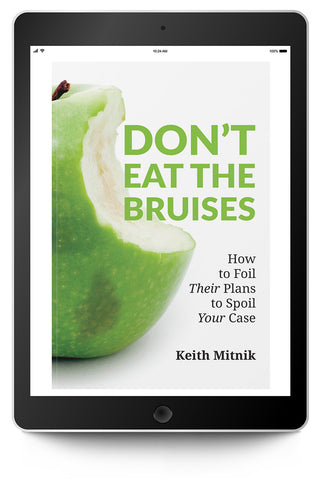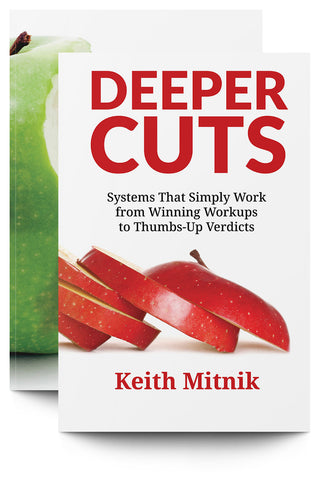In November of 2022, attorney Michael Viglione obtained a $7,265,800 verdict for two senior citizens, ages 86 and 78, who were injured in a car crash. Their case hinged on the plaintiff husband, who suffered a TBI that led to early-onset dementia. Keith Mitnik’s books, Don’t Eat the Bruises and Deeper Cuts, formed the foundation of Viglione’s successful trial strategy, as did several other titles in the Trial Guides catalog.
Verdict Highlights
Plaintiff’s Attorney: Michael Viglione of Ryan Ryan & Viglione
Location: Rosemont, Illinois (Cook County, IL)
Type of Case: Auto accident, TBI, aging client, dementia
Jury Verdict: husband: $7,265,800
Trial Guides Products Used: Don't Eat The Bruises, Deeper Cuts, Trial By Human, Polarizing the Case, Traumatic Brain Injuries (On Demand video)
Case Details
The inciting incident occurred in December of 2018. Michael represented a husband (82) and wife (mid 70s) who were struck by a driver as they were on their way home from a Christmas party. The at-fault driver was from out of town on a cross-country road trip; he missed his turn-off into a pizza place in Rosemont, Illinois, made an illegal U-turn, and hit the plaintiff parties.
The defense relied on several ageist tropes: that the plaintiffs were old, confused, and at fault for the car accident. The plaintiffs’ team had to not only overcome obvious age bias, but also show fault in the accident—and causality between the husband’s TBI and his dementia. “Using the methods outlined in Keith Mitnik’s books, we were able to have a good discussion with the jury panel,” said Michael, “and ultimately, I believe that is why we were successful.”
Damages
The most profound element of damages was the husband’s diagnosed traumatic brain injury, for which he required multiple hospitalizations. He had to go into a nursing home for a month and in the years following the crash went on to develop dementia, resulting in large medical bills and loss of consortium for his wife. “Of course, all of this was disputed by the defense,” explains Michael. “They basically said that the plaintiff had nothing more than a ‘little bump’ on his head, and that anything more than a few days of pain after the crash was unrelated, [or that it] didn't happen. And if it did happen, it was just kind of because he was old.”
Curiously, the defense expert neuropsychologist was not provided several critical pieces of information in the medical records and photos of the injuries. When confronted with these facts on cross-examination, he ended up substantiating a large portion of the plaintiffs’ damages case.
Poor Defendant Behavior
Another peculiarity of this case was the behavior of the defendant and his son, who was also in the car at the time of the crash. Immediately after the crash, the defendant driver and his son got out of their car and started snapping photos of the scene. They went out the following day and took more photographs from all vantage points from the scene itself from across the road from everywhere. Early that morning, they both wrote out statements of what had supposedly happened, pinning everything on the plaintiff driver. Ironically, their own photos and statements were later used to show inconsistencies between the physical evidence and the story they told.
Plaintiff Challenges
Ageism
The biggest challenge for the plaintiff side was the jury’s potential bias towards an older gentleman, driving on a dark, rainy night. “I had to address that issue head-on in voir dire,” explained Michael. “That's really where I followed [Keith Mitnik’s] advice that it's okay to admit these biases to ourselves. I asked potential jurors to picture the scene, with an emphasis on the age of my client. Then I asked them: ‘Do you have an inkling in your mind that he must have caused this crash?’ And people would say yes to that. They would put their hand up and say ‘I'm sorry to say it, but yes, I think he must have been at fault.’ And so those people were all rightfully excused.”
This technique comes from Keith Mitnik's bestselling Don't Eat The Bruises, now available in print and ebook.
Medical Causality
A second challenge for the plaintiffs’ team was convincing the jury to accept the body of medicine that supports the relationship between traumatic brain injuries and rapid-onset dementia. Multiple studies have shown that, when people suffer a traumatic brain injury, their risk of developing dementia increases dramatically; this relationship is more pronounced for TBIs that occur in older adults. This topic is touched upon in Glen Zielinski's Traumatic Brain Injuries, an On Demand video.
Injury Severity
As many traumatic brain injury lawyers can attest, many people believe the dangers of TBIs are overblown. Michael had to counter this bias in voir dire by addressing it directly; this ensured that the selected jurors were prepared to accept the full range of potential problems resulting from the plaintiff’s TBI, including dementia. Michael removed five people on preemptory challenges, and five people for cause: an unsurprisingly high number, considering the topic at hand.
The Verdict
Michael successfully received a verdict of $7,265,800 for his injured clients. This included $120,000 in past medicals, and about $325,000 for future medical, which had to do with in-home care as the dementia will progress. The remainder of the verdict was for noneconomic losses, including $1.51 million for the wife in loss of consortium.
Trial Guides Titles in Action
Michael has been a long-time reader of Trial Guides titles, and credits several of them to this phenomenal verdict:
Keith Mitnik’s Deeper Cuts and Don't Eat the Bruises
“Every element of the trial, from voir dire through the very last word of closing arguments, was based on Keith Mitnik's trial practice systems explored in Don't Eat the Bruises and Deeper Cuts,” explains Michael. “Those systems ensure a fair jury committed to 100% full justice verdicts. We all owe Keith a great debt, and we should all be applying his methods during every trial we conduct. We owe it to our clients.”
Discover Keith Mitnik's library of work here.
Nick Rowley’s Trial By Human
“I love everything [Nick Rowley] writes,” says Michael. “Everything about addressing supposed problems in your case head-on I just steal from him and I just come right out as soon as I start the voir dire and say, you know, ‘I can't sleep at night thinking that you all are going to believe that because this gentleman was 82 years of age he must have caused this crash. Does anyone feel that way?’ That's straight from Trial By Human.”
Rick Friedman’s Polarizing the Case
“[Rick Friedman] has written some phenomenally helpful books,” says Michael, “but I think that Polarizing the Case is especially useful in the context of dealing with defense medical experts. I just told the jury, in both opening and closing, to strip away all of the factual inconsistencies and see what [the defense] really actually wants you to do here. They just expect you to use bias to say, ‘Well, they're old, they're confused.’ So I love that book, and I definitely use all of his concepts as well. It really works.”
 Discover Polarizing the Case by Rick Friedman.
Discover Polarizing the Case by Rick Friedman.
Glenn Zielinski’s Traumatic Brain Injuries (On Demand video)
“I watched a TBI lecture by Glenn Zielinski, a specialized chiropractic physician, several years ago, and that was fantastic in explaining the physiology of traumatic brain injuries,” says Michael. “I bought it on CD during COVID when I didn't have much to do, and listened to it three or four times. Many of his concepts about the physiology of traumatic brain injury I used to explain to the jury, and I think they understood it. They understood what happened at a cellular level with brain injury and then how that's an unfolding process that can lead to all these problems that we call dementia.” Michael wrote an article on this product for his Trial Lawyers Association Journal.
 Get Traumatic Brain Injuries, an On Demand video by Glen Zielinzki.
Get Traumatic Brain Injuries, an On Demand video by Glen Zielinzki.



